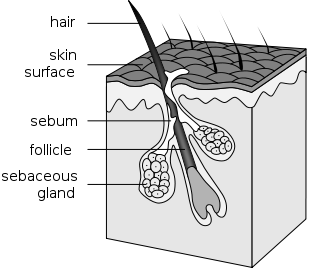Hair Follicle
The hair follicle is what produces the individual strands of hair, and can be found all over the beard area. The follicle is responsible for the shape of the hair it produces, as well as the texture. 
The follicle will have sebaceous glands nearby for the secretion of sebum and is located below the epidermis, within the dermis.
Depending on the individual follicle, it will be in one of three phases in the hair cycle.
Where follicles are will be based on genetics. There are around 90,000-150,000 hair follicles on the scalp, and 5 million total on the male body. If there is no follicle present, there will be no hair produced. This is why some men may have very dense, thick-looking beards compared to other men. The more follicles there are, along with how many of the follicles are active through androgens, the thicker the beard will appear to be. Of course, the hair shaft thickness itself plays a role in that as well.
Beard Shape
For men wondering if they can change the shape of their unruly beard, in any natural way, the answer is no. The best options you'll have are working with the beard, using a beard balm or wax, and/or using a hair dryer.
Ultimately, beyond using a few natural techniques, there's nothing you'll be able to do if you have a tight curl and want a straighter beard. As well as vice versa.
While you might be able to help the fullness of your beard by using something like minoxidil, you cannot change how your hair comes out. In general, the curl of a beard may resemble the hair on your head, although there are many exceptions to this (such as straight-haired men having curly beards). The color of your beard will be determined by genetics, and may not be the same color as your head hair. Even mustaches or soul patches may be different colors from the base beard.
Hair Growth Cycle
Each hair follicle has an independent cycle. While some may be roughly synced, hair will mostly shed independently*. This is not necessarily the case for those using minoxidil to grow a beard, however.
*Independently does not mean single hair will shed at a time.
The three phases of the growth cycle are anagen, catagen, and telogen.
Anagen Phase
This is the phase in which the follicle is actively growing hair. The one that we want most of our hair to be in to achieve the thickest beard possible. Minoxidil, and to an extent, peppermint essential oil are known to cause follicles to go into a state of anagen.
Catagen Phase
Once signaled, the anagen phase goes into the catagen phase. This transitional phase allows the hair to renew itself, and only about 1% of human body hair will be in this phase at any one time.
The length of hair in the phase can still appear to be growing due to it being pushed out during the two weeks it is in effect.
Telogen Phase
The telogen phase is the body's way of conserving its resources while the rest of the hair is in its growth (anagen) phase. It sticks around for one to several months before the hair is shed. In the coming weeks, the follicle will then enter its growth phase.
Shedding Phase
Hair can and will shed, as it is a natural process of cell replacement. If you notice facial hair falling out of your beard daily, you are not losing this hair. It will regrow in the hair follicle.
This natural process is also known as exogen.
Kenogen Phase
The kenogen phase is in between exogen and anagen phases. It's the time when the hair follicle is empty, to when it starts to grow a new hair.
Types of Hair
Vellus hair
Vellus hair is thin, transparent hair all over a person's body. It develops during childhood and can also develop later in life. This hair grows out of hair follicles and has a chance of developing into terminal hair. In general, vellus hair stays vellus unless hormones change enough to alter them or in the presence of a hair-grower like minoxidil.
Over time and as we age, follicles on the body become more sensitive to androgens, allowing vellus hair to maturate. Because of this, beards tend to improve as a person ages.
Vellus hair is not the same thing as lanugo, which is hair that is thicker and grows on fetuses.
Vellus hair is not connected to sebaceous glands, which is a big part of why some people may have a lot of vellus hair on their faces, but are not terminal as they may want.
Transitional or intermediate hair
Commonly referred to as transitional, this type of hair is a variation of vellus that may soon maturate enough to be terminal hair. Transitional hair is a common term used among people using minoxidil for beard growth, as the minoxidil enables the hair to grow longer and receive some pigment.
Terminal hair
Terminal hair is thick, pigmented hair that can grow longer than vellus hair. For men trying to grow fuller beards, this is the type of hair that they will want more of.
During puberty, or through the use of minoxidil, vellus hair is replaced with terminal hair due to the increase of androgenic hormone levels.
Androgenic hair
Androgenic hair is body hair and aptly named because the hair is grown due to follicles metabolizing androgen hormones (testosterone and dihydrotestosterone). It is a more specific way of referring to terminal hair.
Axillary hair
Axillary hair is underarm hair is a subset of androgenic hair.